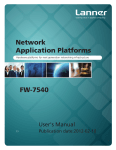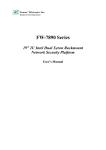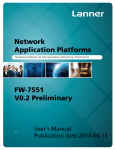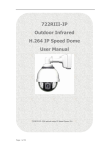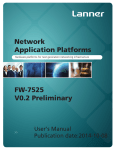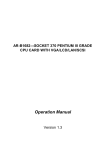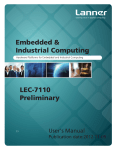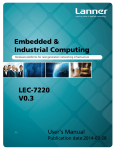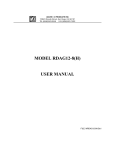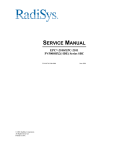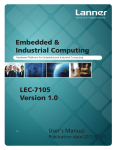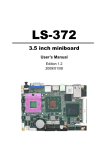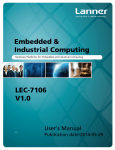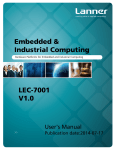Download User Manual
Transcript
Network Application Platforms Hardware platforms for next generation networking infrastructure FW-7541 User's Manual >> Publication date:2012-08-01 About About Overview Icon Descriptions The icons are used in the manual to serve as an indication of interest topics or important messages. Below is a description of these icons: NOTE: This check mark indicates that there is a note of interest and is something that you should pay special attention to while using the product. WARNING: This exclamation point indicates that there is a caution or warning and it is something that could damage your property or product. Acknowledgement Intel, Pentium and Celeron are registered trademarks of Intel Corp. Microsoft Windows and MS-DOS are registered trademarks of Microsoft Corp. All other product names or trademarks are properties of their respective owners. Compliances CE This product has passed the CE test for environmental specifications. Test conditions for passing included the equipment being operated within an industrial enclosure. In order to protect the product from being damaged by ESD (Electrostatic Discharge) and EMI leakage, we strongly recommend the use of CE-compliant industrial enclosure products. FCC Class A Online Resources The listed websites are links to the on-line product information and technical support. Resource Website Lanner http://www.lannerinc.com Product Resources http://assist.lannerinc.com RMA http://eRMA.lannerinc.com Copyright and Trademarks This equipment has been tested and found to comply with the limits for a Class A digital device, pursuant to Part 15 of the FCC Rules. These limits are designed to provide reasonable protection against harmful interference when the equipment is operated in a commercial environment. This equipment generates, uses and can radiate radio frequency energy and, if not installed and used in accordance with the instruction manual, may cause harmful interference to radio communications. Operation of this equipment in a residential area is likely to cause harmful interference in which case the user will be required to correct the interference at his own expense. Safety Guidelines Follow these guidelines to ensure general safety: • This document is copyrighted © 2102. All rights are reserved. The original manufacturer reserves the right to make improvements to the products described in this manual at any time without notice. No part of this manual may be reproduced, copied, translated or transmitted in any form or by any means without the prior written permission of the original manufacturer. Information provided in this manual is intended to be accurate and reliable. However, the original manufacturer assumes no responsibility for its use, nor for any infringements upon the rights of third parties that may result from such use. Network Application Platforms • • • • • • Keep the chassis area clear and dust-free during and after installation. Do not wear loose clothing or jewelry that could get caught in the chassis. Fasten your tie or scarf and roll up your sleeves. Wear safety glasses if you are working under any conditions that might be hazardous to your eyes. Do not perform any action that creates a potential hazard to people or makes the equipment unsafe. Disconnect all power by turning off the power and unplugging the power cord before installing or removing a chassis or working near power supplies Do not work alone if potentially hazardous conditions exist. Never assume that power is disconnected from a circuit; always check the circuit. i About About LITHIUM BATTERY CAUTION: Risk of Explosion if Battery is replaced by an incorrect type. Dispose of used batteries according to the instructions Operating Safety Electrical equipment generates heat. Ambient air temperature may not be adequate to cool equipment to acceptable operating temperatures without adequate circulation. Be sure that the room in which you choose to operate your system has adequate air circulation. Ensure that the chassis cover is secure. The chassis design allows cooling air to circulate effectively. An open chassis permits air leaks, which may interrupt and redirect the flow of cooling air from internal components. Electrostatic discharge (ESD) can damage equipment and impair electrical circuitry. ESD damage occurs when electronic components are improperly handled and can result in complete or intermittent failures. Be sure to follow ESD-prevention procedures when removing and replacing components to avoid these problems. Wear an ESD-preventive wrist strap, ensuring that it makes good skin contact. If no wrist strap is available, ground yourself by touching the metal part of the chassis. Periodically check the resistance value of the antistatic strap, which should be between 1 and 10 megohms (Mohms). EMC Notice This equipment has been tested and found to comply with the limits for a Class A digital device, pursuant to Part 15 of the FCC Rules. These limits are designed to provide reasonable protection against harmful interference when the equipment is operated in a commercial environment. This equipment generates, uses, and can radiate radio frequency energy and, if not installed and used in accordance with the instruction manual, may cause harmful interference to radio communications. Operation of this equipment in a residential area is likely to cause harmful interference in which case users will be required to correct the interference at their own expense. Network Application Platforms ii TTaTTable of Contentsbeable of Conten Chapter 1: Introduction 1 System Specification . . . . . . . . . . . . . . . . . . . . . . . . . . . . . . . . . . . . . . . . . . . . 1 Package Contents . . . . . . . . . . . . . . . . . . . . . . . . . . . . . . . . . . . . . . . . . . . . . . 2 Front Panel Features . . . . . . . . . . . . . . . . . . . . . . . . . . . . . . . . . . . . . . . . . . . . 3 Rear Panel Features . . . . . . . . . . . . . . . . . . . . . . . . . . . . . . . . . . . . . . . . . . . . . 4 Chapter 2: Hardware Setup 5 Preparing the Hardware Installation . . . . . . . . . . . . . . . . . . . . . . . . . . . . . . . . . . 5 Installing the System Memory . . . . . . . . . . . . . . . . . . . . . . . . . . . . . . . . . . . . . . 5 Installing the Hard Disk . . . . . . . . . . . . . . . . . . . . . . . . . . . . . . . . . . . . . . . . . . 6 Installing a CompactFlash Card . . . . . . . . . . . . . . . . . . . . . . . . . . . . . . . . . . . . . 6 Installing 3G SIM Card . . . . . . . . . . . . . . . . . . . . . . . . . . . . . . . . . . . . . . . . . . . 7 Installing Wireless 3G Module . . . . . . . . . . . . . . . . . . . . . . . . . . . . . . . . . . . . . . 7 Mounting . . . . . . . . . . . . . . . . . . . . . . . . . . . . . . . . . . . . . . . . . . . . . . . . . . . 7 Tabletop Mounting . . . . . . . . . . . . . . . . . . . . . . . . . . . . . . . . . . . . . . . . . . 7 Rack Mounting . . . . . . . . . . . . . . . . . . . . . . . . . . . . . . . . . . . . . . . . . . . . . 7 Chapter 3: Motherboard Information 9 Block Diagram . . . . . . . . . . . . . . . . . . . . . . . . . . . . . . . . . . . . . . . . . . . . . . . . 9 Motherboard Layout . . . . . . . . . . . . . . . . . . . . . . . . . . . . . . . . . . . . . . . . . . . 10 Jumper Settings . . . . . . . . . . . . . . . . . . . . . . . . . . . . . . . . . . . . . . . . . . . . . . 11 Chapter 4: BIOS Settings 13 Updating the BIOS . . . . . . . . . . . . . . . . . . . . . . . . . . . . . . . . . . . . . . . . . . . . 13 Accessing the BIOS menu . . . . . . . . . . . . . . . . . . . . . . . . . . . . . . . . . . . . . . . . 14 Navigating the BIOS menu . . . . . . . . . . . . . . . . . . . . . . . . . . . . . . . . . . . . 14 The Main Menu . . . . . . . . . . . . . . . . . . . . . . . . . . . . . . . . . . . . . . . . . . . . 15 Advanced Settings . . . . . . . . . . . . . . . . . . . . . . . . . . . . . . . . . . . . . . . . . 16 Boot Setup . . . . . . . . . . . . . . . . . . . . . . . . . . . . . . . . . . . . . . . . . . . . . . 32 Security Settings . . . . . . . . . . . . . . . . . . . . . . . . . . . . . . . . . . . . . . . . . . . 34 Exit Menu . . . . . . . . . . . . . . . . . . . . . . . . . . . . . . . . . . . . . . . . . . . . . . . 36 Restore on AC Power Loss . . . . . . . . . . . . . . . . . . . . . . . . . . . . . . . . . . . . . 37 Appendix A: Programming Watchdog Timer 38 Appendix B: Setting up Console Redirections 39 iii TTaTTable of Contentsbeable of Conten Appendix C: Programming the LCM 40 Appendix D: Programming LAN Bypass 41 Appendix E: Driver Installation 42 LAN Adapters Driver Installation . . . . . . . . . . . . . . . . . . . . . . . . . . . . . . . . . . . 42 On the Windows OS . . . . . . . . . . . . . . . . . . . . . . . . . . . . . . . . . . . . . . . . . 42 On Linux . . . . . . . . . . . . . . . . . . . . . . . . . . . . . . . . . . . . . . . . . . . . . . . . 43 VGA Driver Installation . . . . . . . . . . . . . . . . . . . . . . . . . . . . . . . . . . . . . . . . . . 44 On the Windows OS . . . . . . . . . . . . . . . . . . . . . . . . . . . . . . . . . . . . . . . . . 44 On Linux . . . . . . . . . . . . . . . . . . . . . . . . . . . . . . . . . . . . . . . . . . . . . . . . 44 Appendix F: Terms and Conditions 45 Warranty Policy . . . . . . . . . . . . . . . . . . . . . . . . . . . . . . . . . . . . . . . . . . . 45 RMA Service . . . . . . . . . . . . . . . . . . . . . . . . . . . . . . . . . . . . . . . . . . . . . 45 iv Chapter 1 Introduction Chapter 1: Introduction System Specification Thank you for choosing the FW-7541. The FW-7541 is a desktop network communication appliance which is built on Intel® Pineview™ embedded processor, the nextgeneration in the Intel ® Atom™ family. FEATURE The FW-7541 is an ideal network system platform. All electronics are protected in a compact sealed rugged case for easy installation in customers’ computer facilities, or it can be used as a stand-alone application situated in your lab or offices where space is limited and the environment is harsh. The FW-7541 can be used as a standalone system, rack mounted or desktop mounted. The system comes in a footprint of only 174mmx140mm (6.85” x 5.51”). The rugged aluminum case not only provides great protection from EMI, EDS, shock/vibration, cold and heat, but also passive cooling for quiet fanless operation (Models C and D are fanless; models A and B are with fans) The six Gigabit LAN ports with hardware bypass (1 pair) capability and Mini-PCIe slot coupled with SIM card connector answer the demand for versatility in networking applications. It also supports a 2.5” SATA HDD and CompactFlash for storage. All of the above mentioned are packed into a small rugged unit (268mmx40mmx145mm) (10.55”x1.57”x5.71”). Please refer to the chart below for a summary of the system’s specifications. Form Factor Desktop Processor Onboard Dual-Core Intel® ATOM D525 1.8 GHz Chipset Intel ICH8M Technology DDR3 667/800 MHz, non-ECC Max Capacity 4GB Socket 1x204P SO-DIMM Platform System Memory Windows (2000, 2003, XP) Linux Kernel 2.4 and up OS Support Storage Networking I/O Interface Expansion Cooling Environmental Parameters Miscellaneous Physical Dimensions Power Approvals & Compliance Ordering Info Network Application Platforms DESCRIPTION HDD Bay(s) 1 x 2.5” Storage Interface 1 x Serial ATA, 1 x CompactFlash Ethernet Ports 6 x GbE ports Controller 1 x Intel 82574L LAN Chip 5 x Intel 82583V LAN Chip By-Pass 1 pair optional Console 1 x RJ45 USB 2.0 2 x USB 2.0 Mini-PCIe 1 Processor Passive Heatsink System Passive Heatsink Temperature, ambient operating / storage 0ºC ~40ºC / -20ºC~70ºC Humidity (RH), ambient operating and non-operating 5 ~ 95%, non condensing Watchdog Yes Internal RTC with Li Battery Yes Dimensions (WxHxD) 268x 40 x 145mm Weight 1.2KG Type / Watts 60W Adapter System Input 12V DC CE Emission, FCC Class A, RoHS Please note that Fanless models (models C/D) only support industrial HDD 1 Chapter 1 Introduction Package Contents Your package contains the following items: • FW-7541 Network Security Platform • Power cable • 1 crossover Ethernet cable (1.8 meters) • 1 straight-through Ethernet cable (1.8 meters) • 1 RJ-45 to DB-9 female console cable • Serial-ATA hard drive cable • 1 tabletop mounting screw pack • 1 hard disk installation screw pack (only supplied with systems shipped without pre-installed hard disks) including the following items: • ESD protection pad to cover the exposed screws from hard disk installation • Hard disk mounting screws • Hard disk anti-vibration rubber (blue) For instructions on hard disk installation, refer to Installing the Hard Disk on Chapter 2 Hardware Setup. • • (Optional accessory) Rack mounting kit which contains the following items: • Rack mounting bracket • Rack mounting screw pack including cable holder and screws for rack mounting (flat head screws) and cable holder (threaded oval head screws) Drivers and user’s manual CD. Network Application Platforms 2 Chapter 1 Introduction Front Panel Features F4 F1 F2 F3 LAN1 LAN2 LAN3 LAN4 LAN5 LAN6 F1 Console Port By using suitable rollover cable (Cisco console cable), you can connect to a computer terminal for diagnostic or configuration purpose. Terminal Configuration Parameters: 115200 baud, 8 data bits, no parity, 1stop bit, and no flow control. F2 HDD/Status/Power LED HDD: If the LED blinks, it indicates data access activities; otherwise, it remains off. Status: This LED is programmable. You could program it to display the operating status with the behavior like: If the LED is green, it indicates that the system’s operational state is normal. If it is amber, it indicates that the system is malfunctioning. Power: If the LED is on it indicates that the system is powered on. If it is off, it indicates that the system is powered off. F3 Two USB 2.0 Ports It connects to any USB devices, for example, a flash drive. F4 6 Gigabit LAN ports Left LED:If the LED is green, it indicates that the connection speed is 100Mbps. If the LED is orange, it indicates that the connection speed is 1000Mbps. Right LED: If the LED is on, it indicates that the port is active. If it blinks, it indicates there is traffic. Using suitable RJ-45 cable, you can connect FW-7541 System to a computer, or to any other piece of equipment that has an Ethernet connection; for example, a hub or a switch. Moreover,1 pair (LAN1-LAN2) can be configured as LAN Bypass when failure events occur. LAN 1 is also capable of the Preboot Execution Environment (PXE) function. The LAN Bypass feature can be implemented with watch dog timer functionality. Look for the Driver and User’s Manual CD for sample codes on this function. (Read Appendix C for more information). Note: 111 The availability of LAN Bypass varies depending on the model as listed below: Model Bypass or not MB-7541A/C Yes MB-7541B/D No 222 Both PXE and Lan Bypass functionalities can be enabled or disabled in the BIOS. Network Application Platforms 3 Chapter 1 Introduction Rear Panel Features R1 R1 R2 R3 R2 R3 R4 R1 Reset Switch Use a pointed object to press the reset button for about 3 seconds to reboot the system without turning off the power. R2 Power-on Switch It is a switch to turn on or off the power. R3 AC Power-in socket The system requires a 60W/12V switching power supply with lock. R4 System fan (only on models A and B) Note: Models C and D are fanless; models A and B are with fans. Network Application Platforms 4 Chapter 2 Hardware Setup Chapter 2: Hardware Setup Preparing the Hardware Installation To access some components and perform certain service procedures, you must perform the following procedures first. WARNING: To reduce the risk of personal injury, electric shock, or damage to the equipment, remove the power cord to remove power from the device. The Power On/Standby button on the back panel does not completely shut off system power. Portions of the power supply and some internal circuitry remain active until AC power is removed. Notch Cutout Note: 1. SO-DIMM installed must meet the following speed requirement: DDR3 667/800 MHz. Do not install DIMMs with different speeds. 2. The motherboard equips with one SO-DIMM socket — all models can support up to 4GB capacity in maximum . 1. Unscrew the 6 screws from the top cover of the FW7541 System. 2. Open the cover. Installing the System Memory The motherboard supports DDR3 memory that features data transfer rates of 667/800MHz to meet the higher bandwidth requirements of the latest operating system and Internet applications. It comes with one Double Data Rate Type Three (DDR3) Small Outline Dual Inline Memory Module (SO-DIMM) socket. 1. Align the memory module’s cutout with the the SODIMM’s slot notch. 2. Install the SO-DIMM. Network Application Platforms 5 Chapter 2 Installing the Hard Disk Hardware Setup 4 The system can accommodate one Serial-ATA disk (2.5”). Follow these steps to install a hard disk into the FW-7541: 1. Take off the black cap covering the hard disk mounting holes and insert the anti-vibration rubber to the mounting holes. Make sure that the rubber goes through the holes when inserting it. 2. Place hard disk inside the cover and align the corners of the hard disk with the mounting holes on the cover. 3. Secure the hard disk with 4 mounting screws from the outside of the cover. 4. Use the ESD protection pad in the hard disk installation screw pack to cover the exposed screws for ESD protection Note: 1. To Secure a 2.5” hard disk to the tray, use the mounting holes and fasten it with the screws from the outside of the chassis cover as illustrated in step 3 . Make sure that you use the ESD protection pad to cover the exposed screws for ESD protection . 2. Fanless models (models C/D) only support industrial hard disk. 5. Connect the Serial-ATA cables to the HDD. 6. Plug the Serial-ATA drive and power cables to the Serial-ATA drive and the 4-Pin Serial-ATA Power connectors on the main board respectively. 1 Installing a CompactFlash Card FW-7541 provides one CompactFlash slot. Follow the procedures bellow to install a CompactFlash card. 1. Align CompactFlash card and the card slot with the arrow pointing toward the connector. 2 2. Push the card to insert into the connector. 1 2 3 Network Application Platforms 6 Chapter 2 Hardware Setup Installing 3G SIM Card Mounting 1. Unlock the SIM card tray. 2. Align the SIM card and the tray with the cut-off angle. 3. Insert the SIM card into the tray. 4. Close the tray and lock it on the board. Tabletop Mounting To mount the FW-7541 on the table, use the screws and rubber feet in the tabletop mounting screw pack. Follow the following procedures as a guideline: 1. Place the rubber feet on the mounting hole at the bottom of the FW-7541 and fix it firmly by using the screws provided. 3 2. Place the FW-7541 on the table with the rubber feet standing on top of the table. 4 Note: To remove the SIM card, unlock the tray first by sliding it outward. Rack Mounting Installation environment precaution: Installing Wireless 3G Module 1. 1. Align the wireless module’s cutout with the Mini-PCIe slot notch. 2. Insert the wireless module into the connector diagnoally. 3. Push the other end of the wireless module to be tightened with the latch. 2. 2 3. 3 4. 1. Note: To remove the module from the system, release the latch first by slightly bending it inward. Network Application Platforms Elevated Operating Ambient - If installed in a closed or multi-unit rack assembly, the operating ambient temperature of the rack environment may be greater than room ambient. Therefore, consideration should be given to installing the equipment in an environment compatible with the maximum ambient temperature (Tma) specified by the manufacturer. Reduced Air Flow - Installation of the equipment in a rack should be such that the amount of air flow required for safe operation of the equipment is not compromised. Mechanical Loading Mounting of the equipment in the rack should be such that a hazardous condition is not created due to uneven mechanical loading. Mechanical Loading - Mounting of the equipment in the rack should be such that a hazardous condition is not achieved due to uneven mechanical loading. Circuit Overloading - Consideration should be given to the connection of the equipment to the supply circuit and the effect that overloading of the circuits might have on over-current protection and supply wiring. Appropriate 7 Chapter 2 5. consideration of equipment nameplate ratings should be used when addressing this concern. Reliable Earthing - Reliable earthing of rackmounted equipment should be maintained. Particular attention should be given to supply connections other than direct connections to the branch circuit (e.g. use of power strips).” CAUTION : Rail/rack mounted equipment is not to be used as a shelf or a work space. To mount the FW-7541 onto the rack, use the mounting kit with the screw pack. Follow the following procedures as a guideline: 1. Place the FW-7541 on the rack mounting bracket and fix it to the bracket by using the flat head screws in the screw pack. Hardware Setup Connecting Powers Follow theses procedures to power up the FW-7541: 1. Connect one end of the power adapter to the DC jack of the FW-7541 first. 2. Connect the other end of the power cord to the DC power adapter. 3. Lastly, connect the power cord to an electrical outlet. CAUTION: Leave space around your power adapter. Do not use this device in a location where airflow around the power adapter or computer is not sufficient. Always disconnect the power adapter before opening the computer to perform procedures such as installing memory or removing the hard disk. 2. Place the power adaptor in the adaptor slot and attach the cable holder (with threaded oval-head screws) provided to the rack mounting bracket. Make sure that the power adaptor socket is not blocked by the aligning holder in the front. 3. You could use the cable holder to hold your cable to prevent it from tangling as shown in the picture below. Note: Bracket mounting screws for mounting the bracket onto the rack equipment are not included. The original screw pack is for fixing system on the bracket. Network Application Platforms 8 Chapter 3 Motherboard Information Chapter 3: Motherboard Information Block Diagram The block diagram depicts the relationships among the interfaces or modules on the motherboard. Please refer to the following figure for your motherboard’s layout design. Up to 4GB MAX 1x DDR3 667/800Mhz SO-DIMM 2 x 6 Pin Header VGA D525 Processor X4 DMI 2x USB 2.0 2x USB 2.0 Pin Header USB 2.0 CFII socket Mini PCI-E socket 2 x SATA II RJ45 Console Port Console Pin header Winbond W83627DHG-P LPC 6x PCI-E x1 KB/Mouse Intel 82574L 1 x 2.5" HDD Bay supported on the system Intel 82583V Intel 82583V Intel 82583V Intel 82583V Intel 82583V 1 pair bypass on models A/C Network Application Platforms 9 Chapter 3 Motherboard Information Motherboard Layout The motherboard layout shows the connectors and jumpers on the board. Refer to the following picture as a reference of the pin assignments and the internal connectors. VGA Interface Clear CMOS Hardware and Software Reset jumper ATX Power Button SO-DIMM Socket Compact Flash Connector SPI ROM Update Connector Fan Connector LPC I/O bus (Port 80) SATA 1/2 Connectors 140mm Keyboard and Mouse Connectors SATA Power Connector Mini PCI-E Connector SIM Card Serial Port Connector Socket Console Port Ethernet Ports USB2.0 Ports USB 2 and 3 Connectors 174mm Network Application Platforms 10 Chapter 3 Motherboard Information Jumper Settings SO-DIMM Socket (CN1): The single memory slot (204 pin) is for connecting the DDR3 SO-DIMM (Small Outline Dual In-line Memory Module) 667/800 memory. The system can suport up to 4 GB in maximum. FAN Connector (FAN1): The 3-pin connector is for connecting the system fan.The BIOS will list the CPU and system fans’ monitored temperature and speed under the menu of Hardware Health Configuration. You could also configure the target temperature to adjust the fan speed automatically. 1 2 3 Function PIN NO. Ground 1 +12V Fan Status 2 3 ATX Power Button (CN2): The power button has a 2-pin connector; the pin definition is as the following: V-SYNC H-SYNC Blue Green Red 9 7 5 3 1 Pin name PANSW GND VGA Interface (J1): It is for connecting the VGA interface cable. CompactFlash Connector (CN4): It is for connecting a Compact Flash card to be served as your system's storage. The socket is CF type II and can fit into both bype I and type II cards. Serial-ATA Power Connector (J8): It is used for connectig the SATA power cord. PIN NO. Function 1 VCC(12V) VGA Interface Connector (J1): VGA Interface (J1): It is for connecting the VGA interface cable (2x6 to female DB15). F u n c - DD_ tion DATA PIN NO. 11 Pin No. 1 2 1 2 2 GND 3 GND 4 VCC(5V) 4 3 2 1 Keyboard and Mouse Connector (J7): It is for connectig the PS/2 keyboard and mouse interface cable. 11 9 7 5 3 1 12 10 8 6 4 2 PIN NO. 12 10 8 6 4 2 F u n c - DD_CLK GND GND GND GND C R T tion ON Hardware or Software Reset Jumper(JP2): The jumper can be adjusted to be in either hardware or software reset mode when the reset switch is pressed. The 1 hardware reset will reboot the system without turning off the power. 2 The software reset can be programmed to reset a software to its default setting. 3 1 2 3 Pin No. 1-2 2-3 Function Software Reset Hardware Reset Clear CMOS jumper (JP1): It is for clearing the CMOS memory 1and system setup parameters by erasing the data 2stored in the CMOS RAM such as the system passwords. 3 1 2 3 P i n Function No. 1 VCC 3 MSDATA 5 KBDATA 7 GND 1 3 5 7 2 4 6 8 Pin No. Function 2 MSCLK 4 KEY 6 KEY 8 KBCLK SATA 1 and 2 Connectors(J5, J6): It is for connecting a 2.5’’ SATA harddisk to be served as your system’s storage. The ICH8 chipset supports the Serial ATA Specification Revision 2.5. with data transfer rates up to 3.0 Gb/s(300 MB/s). Note that models E/F/G/H only support industrial Hard disk. 1 2 3 4 5 6 7 Pin No. 1 2 3 4 5 6 7 Function Ground Ground TX+ TXGround RXRX+ Pin No. Function 1-2 (Default) Normal 2-3 Clear CMOS Network Application Platforms 11 Chapter 3 Motherboard Information The controller contains two modes of operation—a legacy mode using I/O space, and an AHCI mode using memory space. Software that uses legacy mode will not have AHCI capabilities. SPI-ROM Update Connector (J3): Using the appropriate cable to connect this 10-pin ISP pin header connector, the user can update the SPI Flash soldered on board. The AHCI ( Advanced Host Controller Interface) is a programming interface which defines transactions between the SATA controller and software and enables advanced performance and usability with SATA. Platforms supporting AHCI may take advantage of performance features such as no master/slave designation for SATA devices—each device is treated as a master—and hardware assisted native command queuing. AHCI also provides usability enhancements such as Hot-Plug. Here is the list of the AHCI capabilities which exist in the system: Function Pin No. NC SPI_CS0 SPI_ICH_MISO KEY GND 1 3 5 7 9 1. Hardware assisted native command queuing 2. Aggressive power management 3. LED indicator support Note: To configure your hard disk as AHCI compatible, use the BIOS menu. Refer to IDE Configuration Settings on Chapter 4 BIOS Settings. Also, Intel(R) Matrix Storage Manager (for use on systems using Intel(R) 82801HBM I/O Controller Hub (ICH8M)- AHCI only) has to be installed, for more information, visit http://downloadcenter. intel.com/Detail_Desc.aspx?lang=eng&chan geLang=true&DwnldId=19607 Serial Interface Connectors(J9): It is for connecting the RS-232 serial port module cable. This is COM2 where as the external console port (RJ45) is COM1. Function Pin No. Data Carrier 1 Detected Received Data 3 Transmitted 5 Data Data Terminal 7 Ready Signal Ground 9 1 3 5 7 9 Function 2 Pin No. 2 Data Set Ready 4 4 Request to 6 Send 8 6 Clear to Send 10 8 Ring Indicator 10 Signal Ground Network Application Platforms 1 3 5 7 9 2 4 6 8 10 Pin No. Function 2 NC 4 V_3P3_SPI 6 8 10 SPI_HOLD0_L SPI_ICH_CLK SPI_ICH_ MOSI LPC I/O bus (Port 80 output for Debug Card) (J4): It is Intel proprietary connector for connecting a checkpoint device to output checkpoints throughout bootblock and Power-On Self Test (POST) to indicate the task the system is currently running. Pin No. 10 8 6 4 2 Function 10 GND 8 GND 6 +3.3V LPC_LAD0 4 LPC_LAD1 2 9 7 5 3 1 Pin No. Function 9 7 5 3 1 LPC_AD2 LPC_AD3 LPC_FRAME_N RST_80DGPT_N CLK_33M_P80 SIM Card Tray (CN5): It is for connecting SIM card for mobile Internet connection. Mini-PCIe Socket(CN6): It is for connecting WiFi module to serve Wireless LAN connections or connecting Wireless 3G module for mobile Internet connections. The socket is provided through the Universal Serial Bus (USB) 2.0 host interface. USB Connector(USB 2 and 3, J11) : It is for connecting the USB module cable. It complies with USB2.0 and is capable of low-speed, full-speed, and high-speed which can support up to 480 Mbps connection speed. Function Pin No. USB_VCC Key USBD0USBD0+ Ground 1 3 5 7 9 1 3 5 7 9 2 4 6 8 10 Pin No. Function 2 Ground 4 USBD1+ 6 USBD18 Key 10 USB_VCC 12 Chapter 4 Bios Settings Chapter 4: BIOS Settings Updating the BIOS The Basic Input/Output System (BIOS) can be updated using the designated Flash Utility. To obtain the utility, please contact us either through the sales rep or technical support. Note: For the update version of the BIOS image, please visit Lanner’s support page at http://assist.lannerinc.com. Then select support center from the Main Menu and look under the folder for the desired product category. The resources for each product including the BIOS image will be contained within a folder named by the product model. Network Application Platforms 13 Chapter 4 Bios Settings Accessing the BIOS menu You will need to enter the BIOS Setup program to configure the system when you are installing a motherboard or when the system prompts “Run Setup” during start-up. This section explains how to configure your system using this program. Even if you have never enter the BIOS Setup program when you are installing a motherboard, you can change the configuration of your computer in the future with the BIOS Setup program. For example, you may want to enable the security password feature or change the power management settings. This requires you to configure your system using the BIOS Setup program so that the computer can recognize these changes and record them in the CMOS RAM . The Setup program is designed to make it as easy to use as possible. Being a menu-driven program, it lets you scroll through the various sub-menus and make your selections from the available options using the navigation keys. Note: This manual describes the standard look of the setup screen. There may be some instances in which the motherboard features can vary from one to another due to customization. This means that some of the options described in this manual mays not match that of your motherboard’s AMIBIOS. Navigating the BIOS menu The BIOS setup utility uses a key-based navigation system called hot keys. Most of the BIOS setup utility hot keys can be used at any time during the setup navigation process. Keys -><- Left/Right -> >- When you start up the computer, the system provides you with the opportunity to run this program. Press <Delete> during the Power-On-Self-Test (POST) to enter the Setup utility (There are a few cases that other keys are used, such as <F1>, <F2>, and so forth.); otherwise, POST continues with its test routines. Up/Down +- Plus/Minuss Tab Description The Left and Right <Arrow> keys allow you to select an setup screen. For example: Main screen, Advanced screen, Boot screen, and so on. The Up and Down <Arrow> keys allow you to select an setup item or sub-screen. The Plus and Minus <Arrow> keys allow you to change the field value of a particular setup item. For example: Date and Time. The <Tab> key allows you to select setup fields. Note: The <F8> key on your keyboard is the FailSafe key. It is not displayed on the key legend by default. To set the Fail-Safe settings of the BIOS, press the <F8> key on your keyboard. It is located on the upper row of a standard 101 keyboard. The Fail-Safe settings allow the motherboard to boot up with the least amount of options set. This can lessen the probability of conflicting settings. These keys include <F1>, <F10>, <Enter>, <ESC>, <Arrow> keys, and so on. Network Application Platforms 14 Chapter 4 Bios Settings The Main Menu The main BIOS setup menu is the first screen that you can navigate. Each main BIOS setup menu option is described in this chapter. The Main BIOS setup menu screen has two main frames. The left frame displays all the options that can be configured. “Grayed-out” options are configured parameters and cannot be modified. On the other hand, Options in blue can be modified. The right frame displays the key legend. Above the key legend is an area reserved for a text message. When an option is selected in the left frame, it is highlighted in white. Often a text message will accompany it. System Time/System Date Use this option to change the system time and date. Highlight System Time or System Date using the <Arrow> keys. Enter new values through the keyboard. Press the <Tab> key or the <Arrow> keys to move between fields. The date must be entered in MM/DD/YY format. The time is entered in HH:MM:SS format. Network Application Platforms 15 Chapter 4 Bios Settings Advanced Settings Select the Advanced tab from the setup screen to enter the Advanced BIOS Setup screen. You can select any of the items in the left frame of the screen, such as SuperIO Configuration, to go to the sub menu for that item. You can display an Advanced BIOS Setup option by highlighting it using the <Arrow> keys. All Advanced BIOS Setup options are described in this section. The Advanced BIOS Setup screen is shown at the right. The sub menus are described on the following pages. CPU Configuration This setting allows the users to view and configurae the settings of the CPU installed on the system. Option Manufacturer CPU Frequency/ FSB Speed Cache L1, Cache L2 Ratio Actual Value MAX CPUID Value Limit Description This shows the CPU brand name. This shows the CPU frequency and Front Side Bus frequency in Megahertz. This specifies the size of the Level 1 and Level 2 caches in Kilobytes. This shows the actual CPU ratio. The CPUID tells the OS/BIOS what the maximum capabilities are for the processor. When enabled, the processor will limit the maximum CPUID input value to 03h when it is queried by the operating system, even if the processor supports a higher CPUID input value. When disabled, the processor will return the actual maximum CPUID input value of the processor when it is queried by the operating system. It is recommended that you leave it at the default setting of Disabled. You should only enable it if you intend to use the Intel Pentium 4 processor with Hyper-Threading Technology with an operating system that does not support it. Execute-Disable Execute Disable Bit is an Intel hardware-based Bit Capability security feature that can reduce exposure to viruses and malicious-code attacks. To use Execute Disable Bit, you must also install a supporting operating system. Network Application Platforms 16 Chapter 4 Bios Settings Option Description Hyper Threading This option allows the user to enable or Technology disable the HyperThreading™ support of the Intel® HT capable processors. By default this setting is enabled. This setting should be disabled in Microsoft™ Windows 2000 or older systems. IDE Configuration Settings You can use this screen to select options for the IDE Configuration Settings. Use the up and down <Arrow> keys to select an item. Use the <Plus> and <Minus> keys to change the value of the selected option. A description of the selected item appears on the right side of the screen. The settings are described on the following pages. An example of the IDE Configuration screen is at the right. Primary IDE Master, Primary IDE Slave, Secondary IDE Master, Secondary IDE Slave: Select one of the hard disk drives to configure it. Press <Enter> to access its the sub menu. The options on the sub menu are described as in the following.. Network Application Platforms 17 Chapter 4 Bios Settings Primary /Secondary IDE Master and Slave Sub Menu From the IDE Configuration screen, press <Enter> to access the sub menu for the primary/secondary IDE master and slave drives. Use this screen to select options for the Primary and Secondary IDE drives. Use the up and down <Arrow> keys to select an item. Use the <Plus> and <Minus> keys to change the value of the selected option. The settings are described on the following pages. The screen for the Primary IDE Master is shown at the right. Type This option sets the type of device that the AMIBIOS attempts to boot from after the Power-On-Self-Test (POST) has completed. Option Description Not Installed Set this value to prevent the BIOS from searching for an IDE disk drive on the specified channel. Auto Set this value to allow the BIOS to automatically detect the IDE disk drive type attached to the specified channel. This setting should be used if an IDE hard disk drive is attached to the specified channel. This is the default setting. CDROM This option specifies that an IDE CD-ROM drive is attached to the specified IDE channel. The BIOS will not attempt to search for other types of IDE disk drives on the specified channe. ARMD This option specifies an ATAPI Removable Media Device. This includes, but is not limited to: • ZIP • LS-120 LBA/Large Mode LBA (Logical Block Addressing) is a method of addressing data on a disk drive. Option Disabled Auto Description Set this value to prevent the BIOS from using Large Block Addressing mode control on the specified channel. Set this value to allow the BIOS to automatically detect the Large Block Addressing mode control on the specified channel. This is the default setting. Block (Multi-Sector Transfer) This option sets the block mode multi sector transfers option. Network Application Platforms 18 Chapter 4 Option Disabled Auto Bios Settings Description Set this value to prevent the BIOS from using Multi-Sector Transfer on the specified channel. The data to and from the device will occur one sector at a time. Set this value to allow the BIOS to automatically detect device support for Multi-Sector Transfers on the specified channel. If supported, Set this value to allow the BIOS to automatically detect the number of sectors per block for transfer from the hard disk drive to the memory. The data transfer to and from the device will occur multiple sectors at a time. This is the default setting. PIO Mode IDE PIO (Programmable I/O) mode programs timing cycles between the IDE drive and the programmable IDE controller. As the PIO mode increases, the cycle time decreases. Option Auto 0 1 2 3 4 Description Set this value to allow the BIOS to auto detect the PIO mode. Use this value if the IDE disk drive support cannot be determined. This is the default setting. Set this value to allow the BIOS to use PIO mode 0. It has a data transfer rate of 3.3 MBs. Set this value to allow the BIOS to use PIO mode 0. It has a data transfer rate of 5.2 MBs. Set this value to allow the BIOS to use PIO mode 0. It has a data transfer rate of 8.3 MBs. Set this value to allow the BIOS to use PIO mode 0. It has a data transfer rate of 11.1MBs. Set this value to allow the BIOS to use PIO mode 4. It has a data transfer rate of 16.6 MBs. This setting generally works with all hard disk drives manufactured after 1999. For other disk drive, such as IDE CD-ROM drives, check the specifications of the drive. DMA Mode This setting allows you to adjust the DMA (Direct memory access) mode options. Option Auto SWDMA0 Description Set this value to allow the BIOS to automatically detect the DMA mode. Use this value if the IDE disk drive support cannot be determined. This is the default setting. Set this value to allow the BIOS to use Single Word DMA mode 0. It has a data transfer rate of 2.1 MBs. Network Application Platforms 19 Chapter 4 Option SWDMA1 SWDMA2 MWDMA0 MWDMA1 MWDMA2 UDMA0 UDMA1 UDMA2 UDMA3 UDMA4 UDMA5 UDMA6 Bios Settings Description Set this value to allow the BIOS to use Single Word DMA mode 1. It has a data transfer rate of 4.2 MBs. Set this value to allow the BIOS to use Single Word DMA mode 2. It has a data transfer rate of 8.3 MBs. Set this value to allow the BIOS to use Multi Word DMA mode 0. It has a data transfer rate of 4.2 MBs. Set this value to allow the BIOS to use Multi Word DMA mode 1. It has a data transfer rate of 13.3 MBs. Set this value to allow the BIOS to use Multi Word DMA mode 2. It has a data transfer rate of 16.6 MBs. Set this value to allow the BIOS to use Ultra DMA mode 0. It has a data transfer rate of 16.6 MBs. It has the same transfer rate as PIO mode 4 and Multi Word DMA mode 2. Set this value to allow the BIOS to use Ultra DMA mode 1. It has a data transfer rate of 25 MBs. Set this value to allow the BIOS to use Ultra DMA mode 2. It has a data transfer rate of 33.3 MBs. Set this value to allow the BIOS to use Ultra DMA mode 3. It has a data transfer rate of 44.4 MBs. To use this mode, it is required that an 80-conductor ATA cable is used. Set this value to allow the BIOS to use Ultra DMA mode 4. It has a data transfer rate of 66.6 MBs. To use this mode, it is required that an 80-conductor ATA cable is used. Set this value to allow the BIOS to use Ultra DMA mode 5. It has a data transfer rate of 99.9 To use this mode, it is required that an 80-conductor ATA cable is used. Set this value to allow the BIOS to use Ultra DMA mode 6. It has a data transfer rate of 133.2 MBs. To use this mode, it is required that an 80-conductor ATA cable is used. S.M.A.R.T. for Hard disk drives Self-Monitoring Analysis and Reporting Technology (SMART) feature can help predict impending drive failures. Option Auto Disabled Enabled Description Set this value to allow the BIOS to automatically detect hard disk drive support. Use this setting if the IDE disk drive support cannot be determined. This is the default setting. Set this value to prevent the BIOS from using the SMART feature. Set this value to allow the BIOS to use the SMART feature on support hard disk drives. Network Application Platforms 20 Chapter 4 Bios Settings 32Bit Data Transfer This option sets the 32-bit data transfer option. Option Disabled Enabled Description Set this value to prevent the BIOS from using 32-bit data transfers. Set this value to allow the BIOS to use 32-bit data transfers on support hard disk drives. This is the default setting. Hard disk drive Write Protect Set this option to protect the hard disk drive from being overwritten. Option Disabled Enabled Description Set this value to allow the hard disk drive to be used normally. Read, write, and erase functions can be performed to the hard disk drive. This is the default setting. Set this value to prevent the hard disk drive from being erased. IDE Detect Time Out (Seconds) Set this option to stop the AMIBIOS from searching for IDE devices within the specified number of seconds. Basically, this allows you to fine-tune the settings to allow for faster boot times. Keep adjusting this setting until a suitable timing in which all all IDE disk drives attached. are detected is found. 0 5 10 Option Description This value is the best setting to use if the onboard IDE controllers are set to a specific IDE disk drive in the AMIBIOS. Set this value to stop the AMIBIOS from searching the IDE bus for IDE disk drives in 5 seconds. A large majority of ultra ATA hard disk drives can be detected well within five seconds. Set this value to stop the AMIBIOS from searching the IDE bus for IDE disk drives in 10 seconds. Network Application Platforms 21 Chapter 4 15 Option 20 25 30 35 Bios Settings Description Set this value to stop the AMIBIOS from searching the IDE bus for IDE disk drives in 15 seconds. Set this value to stop the AMIBIOS from searching the IDE bus for IDE disk drives in 20 seconds. Set this value to stop the AMIBIOS from searching the IDE bus for IDE disk drives in 25 seconds. Set this value to stop the AMIBIOS from searching the IDE bus for IDE disk drives in30 seconds. Set this value to stop the AMIBIOS from searching the IDE bus for IDE disk drives in 35 seconds. ATA(PI) 80 Pin Cable Detection Set this option to specify the Ultra ATA80 cable detection method. Option Host Device Host & Device Description Choose this value to use the IDE controller of the Motherboard to detect the attached IDE cable type (either 80 or 40 pins). Choose this value to use the IDE hard disk to detect the attached IDE cable type (either 80 or 40 pins). Choose this value to use both the IDE hard disk and the IDE controller to detect the attached IDE cable type (either 80 or 40 pins). This is the default setting. SuperIO Configuration In this screen, you will be able to modify the IRQ address of the serial and parallel ports which are provided by the Winbond 83627THG chip. Network Application Platforms 22 Chapter 4 Bios Settings Configure Super IO ChipSet You can use this screen to select options for the Super I/O settings. Use the up and down <Arrow> keys to select an item. Use the <Plus> and <Minus> keys to change the value of the selected option. The settings are described on the following pages. The screen is shown at right. Serial Port1 Address This option specifies the base I/O port address and Interrupt Request address of serial port 1. The Optimal setting is 3F8/IRQ4. The Fail-Safe default setting is Disabled. Option Disabled 3F8/IRQ4 2F8/IRQ3 3E8/IRQ4 Description Set this value to prevent the serial port from accessing any system resources. When this option is set to Disabled, the serial port physically becomes unavailable. Set this value to allow the serial port to use 3F8 as its I/O port address and IRQ 4 for the interrupt address. This is the default setting. The majority of serial port 1 or COM1 ports on computer systems use IRQ4 and I/O Port 3F8 as the standard setting. The most common serial device connected to this port is a mouse. If the system will not use a serial device, it is best to set this port to Disabled. Set this value to allow the serial port to use 2F8 as its I/O port address and IRQ 3 for the interrupt address. If the system will not use a serial device, it is best to set this port to Disabled. Set this value to allow the serial port to use 3E8 as its I/O port address and IRQ 4 for the interrupt address. If the system will not use a serial device, it is best to set this port to Disabled. Network Application Platforms 23 Chapter 4 Option 2E8/IRQ3 Bios Settings Description Set this value to allow the serial port to use 2E8 as its I/O port address and IRQ 3 for the interrupt address. If the system will not use a serial device, it is best to set this port to Disabled. Serial Port2 Address This option specifies the base I/O port address and Interrupt Request address of serial port 2. The Optimal setting is 2F8/IRQ3. The Fail-Safe setting is Disabled. Option Disabled 3F8/IRQ4 2F8/IRQ3 3E8/IRQ4 2E8/IRQ3 Description Set this value to prevent the serial port from accessing any system resources. When this option is set to Disabled, the serial port physically becomes unavailable. Set this value to allow the serial port to use 3F8 as its I/O port address and IRQ 4 for the interrupt address. This is the default setting. The majority of serial port 1 or COM1 ports on computer systems use IRQ4 and I/O Port 3F8 as the standard setting. The most common serial device connected to this port is a mouse. If the system will not use a serial device, it is best to set this port to Disabled. Set this value to allow the serial port to use 2F8 as its I/O port address and IRQ 3 for the interrupt address. If the system will not use a serial device, it is best to set this port to Disabled. Set this value to allow the serial port to use 3E8 as its I/O port address and IRQ 4 for the interrupt address. If the system will not use a serial device, it is best to set this port to Disabled. Set this value to allow the serial port to use 2E8 as its I/O port address and IRQ 3 for the interrupt address. If the system will not use a serial device, it is best to set this port to Disabled. Parallel Port Address This option specifies the I/O address used by the parallel port. The Optimal setting is 378. The Fail-Safe setting is Disabled. Network Application Platforms 24 Chapter 4 Option Disabled 378 278 3BC Bios Settings Description Set this value to prevent the parallel port from accessing any system resources. When the value of this option is set to Disabled, the printer port becomes unavailable. Set this value to allow the parallel port to use 378 as its I/O port address. This is the default setting. The majority of parallel ports on computer systems use IRQ7 and I/O Port 378H as the standard setting. Set this value to allow the parallel port to use 278 as its I/O port address. Set this value to allow the parallel port to use 3BC as its I/O port address. Parallel Port IRQ This option specifies the IRQ used by the parallel port. 5 7 Option Description Set this value to allow the serial port to use Interrupt 5. Set this value to allow the serial port to use Interrupt 7. This is the default setting. The majority of parallel ports on computer systems use IRQ7 and I/O Port 378H as the standard setting. Network Application Platforms 25 Chapter 4 Bios Settings Hardware Health Configuration This menu shows the hardware monitor configuration settings. Select an item then press <Enter> to display the configuration options. Fan1/Fan2 Smart Fan Function It allows you to configure the smart fan feature. You can manually turn on the system fan or set the target system temperature at which the system fan will start running if the fan is not yet turned on. And the system fan can also be turned off automatically if the temperature for the system is at or below the specified value. Refer to Motherboard Layout on Chapter 3 Block Diagram for system fan connectors. AHCI Configuration If you have configured and enabled your SATA disc with an AHCI (Advanced Host Controller Interface) functionality, use this menu to verify whether the system has detected your SATA disc as an AHCI-capable hard disk. Instead of relying on the legacy IDE detection, the AHCI provides advanced features and support for SATA disc management. Network Application Platforms 26 Chapter 4 Bios Settings Remote Access Settings You can use this screen to select options for the Remote Access Configuration. Use the up and down <Arrow> keys to select an item. Use the <Plus> and <Minus> keys to change the value of the selected option. The settings are described on the following pages. The screen is shown at right. Remote Access You can disable or enable the BIOS remote access feature here Option Disabled Serial Description Set this value to prevent the BIOS from using Remote Access. Set the value for this option to Serial to allow the system to use the remote access feature. The remote access feature requires a dedicated serial port connection. Note: The external console port (RJ45) is com1 whereas the serial interface connector (J9) is com2. Network Application Platforms 27 Chapter 4 Bios Settings Serial Port Number Select the serial port you want to use for console redirection. You can set the value for this option to either COM1 or COM2. Option Description 115200 8,n,1 Set this value to allow you to select 115200 as the baud rate (transmitted bits per second) of the serial port. 57600 8,n,1 Set this value to allow you to select 57600 as the baud rate (transmitted bits per second) of the serial port. 19200 8,n,1 Set this value to allow you to select 19200 as the baud rate (transmitted bits per second) of the serial port Note: The external console port (RJ45) is com1 whereas the serial interface connector (J9) is com2. Redirection After BIOS POST A terminal emulation program, such as HyperTerminal, running on the other computer can be used to establish the connection and communicate with the system. There are three possible configurations for console redirection: Option Disabled Description The console is never active, and the serial port is available to the operating system. Always The console is always active and is not available to the operating system. Boot Loader The console is enabled only during BIOS self-test during power-up; after the OS begins to load the console will be disabled and the serial port will be made available to the operating system. Network Application Platforms 28 Chapter 4 Bios Settings USB Configuration In this screen, you will be able to configure the USB controller. You can use this screen to select options for the USB Configuration. Use the up and down <Arrow> keys to select an item. Use the <Plus> and <Minus> keys to change the value of the selected option. The settings are described on the following pages. Note: The device listed under the USB Devices Enabled indicates the auto-detected values. If no device is detected, the item shows None. Legacy USB Support This option enable or disable the support ofr USB devices on legacy operating systems (OS), e.g., Windows ME/98/ NT, and MS-DOS.Normally if this option is not enabled, any attached USB mouse or USB keyboard will not become available until a USB compatible operating system is fully booted with all USB drivers loaded. When this option is enabled, any attached USB mouse or USB keyboard can be used on the system even when there is no USB drivers loaded on it. Option Auto Enabled Disabled Description Allow the system to detect the presence of USB devices at startup. If detected, the USB controller legacy mode is enabled If it is not detected, the USB control er legacy mode is disabled. Enable the support for USB devices on legacy operating system Disable this function. USB 2.0 Controller Mode This option set the USB 2.0 controller to operate in HiSpeed(480 Mbps) or Full Speed (12Mbps). Network Application Platforms 29 Chapter 4 Bios Settings BIOS EHCI Hand-off This option enable or disable the support for the operating systems which does not have an EHCI Hand-Off feature. Option Enabled Disabled Description Enable the support for the OS without EHCI Hand-Off feature. Disable the support for the OS without EHCI Hand-Off feature. USB Mass Storage Device Configuration In this screen, you can configure the attached USB drive to be used as the system’s hard drive. USB Mass Storage Reset Delay This option sets the reset timing for the USB Mass Storage to be initialized. Option Description 10 /20/30/40 When set to 10/20/30/40 Sec, the BIOS will wait sec for up to 10/20/30/40 seconds for the USB flash drive to initialize. Emulation Type USB Emulation refers the system being able to boot to a USB drive. Normally if this option is not enabled, any attached USB drive will not become available until a USB compatible operating system is fully booted with all USB drivers loaded. When this option is enabled, any attached USB drive can boot the system even when there is no USB drivers loaded on the system. Set this value to allow the system to select the Emulation type for a USB drive. Option Auto Floppy Hard Disk Drive Description Set this value to allow the system to automatically detect a USB drive emulation type. Set this value to allow the system to select floppy emulation type. Set this value to allow the system to select hard disk drive emulation type. Network Application Platforms 30 Chapter 4 Bios Settings Lan Bypass Control In this screen, you can configure the Lan Bypass functionality. LAN1 Boot Use this option to turn on or off the Preboot Execution Environment (PXE) functionality of this port. Lan Bypass for Port 1 and Port 2 You can activate or deactivate the Lan Bypass ports. For the description of the physical ports that are capable of the LAN Bypass function, refer to the Front Panel Feature in Chapter 1 Introduction. Lan Bypass for Port1 and Port 2 when power off You can enable or disable the automatic activation of hardware LAN Bypass function in the event of a power failure. Hardware Bypass can automatically activate to allow network traffic to continue. Network Application Platforms 31 Chapter 4 Bios Settings Boot Setup Select the Boot tab from the setup screen to enter the Boot BIOS Setup screen. You can select any of the items in the left frame of the screen, such as Boot Device Priority, to go to the sub menu for that item. You can display an Boot BIOS Setup option by highlighting it using the <Arrow> keys. All Boot Setup options are described in this section. Select an item on the Boot Setup screen to access the sub menu for: •• Boot Settings Configuration •• Boot Device Priority •• USB Drives Boot Settings Configuration In this screen, you will be able to configure the boot procedures and the related elements. Quick Boot Enabling this item allows the BIOS to skip some poweron self-tests (POST) while booting to decrease the time needed to boot the system. When set to [Disabled], BIOS performs the complete series of tests. Select Enabled or Disabled to enable or disable the quick boot Quiet Boot Enabling this item allows the BIOS to suppress the messages displayed during the POST. AddOn ROM Display Mode This option controls the display of ROM messages form the BIOS of add-on devices such as the graphics card or the SATA controller during the start-up sequence. Force BIOS Option Keep Current Description When setting to Force BIOS, third-party ROM messages will be forced to display during the start-up sequence. When setting to Keep Current, third-party ROM messages will only be displayed if the device’s manufacturer has set the addon device to do so. Bootup Num-Lock This option lets you to enable or disable the function of the NumLock key. Network Application Platforms 32 Chapter 4 Bios Settings PS/2 Mouse Support It lets you enable or disable support for PS/2 mouse. Wait for ‘F1’ if error It determines whether the message, “Press F1 to continue” should be displayed when error occurs during start-up. Option Enabled Disabled Description When setting to enabled, the system displays the message, “Press F1 to continue” and waits for the input. when error occurs during start-up. When setting to Disabled, the system will not halt the start-up sequence even when an error is detected. Hit ‘DEL’ Message Display When this item is set to Enabled, the system displays the message , “Press DEL to run Setup” during the start-up sequence. Interrupt 19 Capture Set this value to allow option ROMs such as network controllers to trap BIOS interrupt 19. Option Disabled Enabled Description The BIOS prevents option ROMS from trapping interrupt 19. The BIOS allows option ROMs to trap interrupt 19. Boot Device Priority Use this screen to specify the order in which the system checks for the device to boot from. To access this screen, select Boot Device Priority on the Boot Setup screen and press <Enter>. The following screen is displayed at right: Network Application Platforms 33 Chapter 4 Bios Settings Security Settings Select Security Setup from the Setup main BIOS setup menu. All Security Setup options, such as password protection and virus protection, are described in this section. To access the sub menu for the following items, select the item and press <Enter>: Supervisor Password It indicates whether a supervisor password has been set. If the password has been installed, it displays, “Installed “. If not, it displays, “Not Installed”. The system provides both a Supervisor and a User password. If you use both passwords, the Supervisor password must be set first. The system can be configured so that all users must enter a password every time the system boots or when Setup is executed, using either the Supervisor password or User password. If you select password support, you are prompted to enter a password with one to six characters. Type the password on the keyboard. The password does not appear on the screen when typed. Make sure you write it down. If you forget it, you must clear the CMOS ram and reconfigure it. User Password It indicates whether a user password has been set. If the password has been installed, it displays, “Installed “. If not, it displays, “Not Installed”. Network Application Platforms 34 Chapter 4 Bios Settings Change Supervisor Password Select this option and press <Enter> to access the sub menu. You can use the sub menu to change the supervisor password. Change User Password Select this option and press <Enter> to access the sub menu. You can use the sub menu to change the user password. Clear User Password Select this option and press <Enter> to access the sub menu. You can use the sub menu to clear the user password. Network Application Platforms 35 Chapter 4 Bios Settings Exit Menu Select the Exit tab from the setup screen to enter the Exit BIOS Setup screen. You can display an Exit BIOS Setup option by highlighting it using the <Arrow> keys. All Exit BIOS Setup options are described in this section. The Exit BIOS Setup screen is at right. Saving Changes and Exit When you have completed the system configuration changes, select this option to leave Setup and reboot the computer so the new system configuration parameters can take effect. . Discard Changes and exit Select this option to discard changes and exit.USB drive can boot the system even when there is no USB drivers loaded on the system. Set this value to allow the system to select the Emulation type for a USB drive. Option Auto Floppy Hard Disk Drive Description Set this value to allow the system to automatically detect a USB drive emulation type. Set this value to allow the system to select floppy emulation type. Set this value to allow the system to select hard disk drive emulation type. Discard Changes and Exit Setup Now? Select this option to quit Setup without making any permanent changes to the system configuration. Select this option and press <Enter>. Load Optimal Defaults It automatically loads a complete set of default settings to all Setup options when you Select this option. The Optimal settings are designed for maximum system performance, but may not work best for all computer applications. In particular, do not use the Optimal Setup options if your computer is experiencing system configuration problems. Select Load Optimal Defaults from the Exit menu and press <Enter>. Network Application Platforms 36 Chapter 4 Bios Settings Restore on AC Power Loss This option lets you set the state of the system when it has just recovered from a power outage. Option Power Off Power On Last State Description When setting to Power Off, the system goes into “off state” after an AC power interruption. When setting to Power on, the system turns on automatically after a power interruption When setting to Last State, the system goes into whatever the state was before the power interruption. Network Application Platforms 37 Appendix A Programming Watchdog Timer Appendix A: Programming Watchdog Timer A watchdog timer is a piece of hardware that can be used to automatically detect system anomalies and reset the processor in case there are any problems. Generally speaking, a watchdog timer is based on a counter that counts down from an initial value to zero. The software selects the counter’s initial value and periodically restarts it. Should the counter reach zero before the software restarts it, the software is presumed to be malfunctioning and the processor’s reset signal is asserted. Thus, the processor will be restarted as if a human operator had cycled the power. For sample watchdog code, see watchdog folder on the Driver and Manual CD To program the watchdog timer, you must write a program which writes I/ O port address 443 (hex). The output data is a value of time interval. The value range is from 01 (hex) to 3E (hex), and the related time interval is 1 sec. to 62 sec. Data Time Interval 01 1 sec. 02 2 sec. 03 3 sec. 04 4 sec. .. .. .. 3E 62 sec. After data entry, your program must refresh the watchdog timer by rewriting the I/O port 443 (hex) while simultaneously setting it. When you want to disable the watchdog timer, your program should read I/O port 443 (hex). For sample watchdog code, see watchdog folder on the Driver and Manual CD Network Application Platforms 38 Appendix B Setting up Console Redirection Appendix B: Setting up Console Redirections Console redirection lets you monitor and configure a system from a remote terminal computer by re-directing keyboard input and text output through the serial port. This following steps illustrate how to use this feature. 1. Connect one end of the console cable to console port of the system and the other end to serial port of the Remote Client System. 2. Configure the following settings in the BIOS Setup menu for the device: Please refer to the Remote Access Settings on Chapter 4 BIOS Settings. BIOS > Advanced > Remote Access Configuration > Serial Port Mode > [115200, 8 , n ,1 ] 3. Configure Console Redirection on the client system. The following illustration is an example on Windows platform: a. A. Click the start button, point to Programs > Accessories > Communications and select Hyper Terminal. b. B. Enter any name for the new connection and select any icon. c. Click OK. d. From the “Connect to”. Pull-down menu, select the appropriate Com port on the client system and click OK. e. Select 115200 for the Baud Rate, None. for Flow contorl, 8 for the Data Bit, None for Parity Check, and 1 for the Stop Bit. Network Application Platforms 39 Appendix C Appendix C: Programming the LCM The LCD panel module (LCM) is designed to provide realtime operating status and configuration information for the system. For sample LCM code, see LCM foler on the Driver and Manual CD. The driver and the program library can also be found in the folder. LCM & KeyPad Function Libary For Linux Programming the LCM want to show. =>Showdata1 Shown on Line1 Limited between 20 Character =>Showdata2 Shown on Line2 Limited between 20 Character Ex. Show_data(0,15,0,56,”1234”,”5678”); File: LLCM1 Copy LCM1.O to your make tool directory. Ex. if your test program file name is ‘LLCM2 Compile: ‘gcc LLCM1 -o LLCM2 LLCM2.c’ then switch to a root account to run ./LLCM2 for excution. Function: Clear_LCM(); =>This Function is Clear the LCD Module. =>Direct write the function to your program. Read_KeyPad(); =>This Function get the KeyPad number if user pressed key. =>Direct write function to your program. Ex. int a; a=Read_KeyPad(); Return Value: “1”=>The Upper Key “2”=>The Down Key “3”=>The Enter Key “4”=>The ESC Key 3.Show_Data(int Dp_Type1,int Dp_Type2,int Dp_Type3,int Dp_Type4, char *Showdata1, char *Showdata2); =>Show string Function. =>Dp_type1 => Entry Mode Set =>Dp_type2 => Display On/Off =>Dp_type3 => Shift =>Dp_type4 => Set Function Please refer the Data Sheet about LCM and Use Decimal to input =>Showdata1 & Showdata2 are the strings that you Network Application Platforms 40 Appendix D Appendix D: Programming LAN Bypass The bypass function is used to link two independent Ethernet ports when the system crash or powers off. This means if your system is equipped with a LAN Bypass function, a condition in your system will not interrupt your network traffic. There are typically two communication statuses for the bypass function, one is “Normal” status and another is “Bypass” status. Lanner provides the following methods for enabling the LAN Bypass function: 1. The Lan bypass can be turned on or off in two system states, i.e., power on and power off. The following are the BIOS menu and illustration of the possibilities of LAN bypass configuration with respect to both power-on and power-off states. Programming LAN Bypass Bypass settings LAN Bypass for Port1 and Port 2 System Status Enabled Disabled PWR ON Bypass Non-Bypass PWR OFF Bypass Bypass LAN Bypass 1&2 when power off Enabled Bypass settings LAN Bypass for Port1 and Port 2 System Status Enabled Disabled PWR ON Non-Bypass Non-Bypass PWR OFF Non-Bypass Non-Bypass LAN Bypass 1&2 when power off Disabled 2. A watchdog timer can be used to control the LAN Bypass function dynamically by programming. Lanner also provides sample code for bypass control with WDT via programming. For sample code, look in the LAN_Bypass_Watchdog directory under Driver and Manual CD. To compile: #gcc wdbp.c -o wdbp then switch to a root account to run ./wdbp for excution: #./wdbp Commands: Enable the bypass #wdbp.exe –f Set Watchdog Timer. This command will set the time interval at which the counter will start count down. #wdbp.exe -wl xxx (xxx: 1-255 sec for timer count down) Reset Watchdog Timer. This command will reset the watchdog timer’s counter and the bypass status to non-bypass. #wdbp.exe -wr xxx (xxx: 1-255 sec for timer count down) For a description of the physical LAN ports equipped with this functionality, refer to Front Panel Features in Chapter 1 Introduction. Network Application Platforms 41 Appendix E Driver Installation Appendix E: Driver Installation LAN Adapters Driver Installation This section provides the instructions on how to install Intel® Gigabit LAN adapter drivers. On the Windows OS To install the Intel® Gigabit LAN controller driver on a Windows Operating System: To install the Intel® Gigabit LAN controller driver on a Windows Operating System: 7. Select the programs that you wish to install. Make sure that you have selected the drivers. 1. Restart the computer, and then log on with Administrator privileges. 2. Insert the Drivers and User’s Manual CD to the USBoptical drive. 3. Browse the contents of the support CD to locate the file PRO2KXP.EXE from the \Driver\LAN folder. Doubleclick the Executable file. 4. The program starts by extracting the file. Click Next to continue the installation process. 5. Click Next when the Intel® PRO Network Connections –InstallShield Wizard window appears. 8. Click Nest and then Install to proceed the installation. 9. Click Finish to close the installation program. To verify the LAN controller driver installation, do the following steps: 1. Right-click on the My Computer icon, and then select Properties form the menu. Click the Hardware tab, then click the Device Manager button. Click the + sign next to the Network adapters, then the Intel Pro/1000 [......................] adapter should be listed. 6. Select the “I accept the terms in the license agreement” and then click Next. Network Application Platforms Note: The system uses Intel 82574L and 82583V Ethernet controllers, you could obtain the latest drivers at the Intel download center: http://www.intel.com/products/ethernet/ You could also use the web based utility to detect the needed drivers automatically by visiting the following website: http://www.intel.com/support/network/detect.htm 42 Appendix E On Linux Follow these instructions when installing the Intel® LAN controller base driver for the in Red Hat® and Linux operating system. 1. Insert the motherboard/system support CD to the optical drive and mount the optional drive in the Linux platform. 2. Copy the base driver tar file from the motherboard/ system support CD to the directory of your local hard disk. The Intel® LAN driver for Linux OS is located in the following directory: \Driver\LAN_Driver\PRO1000\LINUX. The name format of driver file is “e1000-<Version>.tar.gz”. For example: the file name of driver version 7.0.38 is “e1000-7.0.38. tar.gz”. Driver Installation 8. Assign an IP address to the interface by entering the following, where <x> is the interface number: ifconfig eth<x> <IP_address> 9. Verify that the interface works. Enter the following, where <IP_address> is the IP address for another machine on the same subnet as the interface that is being tested: ping <IP_address> Note: The system uses Intel 82574L and 82583V Ethernet controllers, you could obtain the latest drivers at the Intel download center: http://www.intel.com/products/ethernet/ 3. Untar/unzip the archive, where <x.x.x> is the version number for the driver tar file: tar zxf e1000-<x.x.x>.tar.gz 4. Change to the driver src directory on your system, where <x.x.x> is the version number for the driver tar: cd e1000-<x.x.x>/src/ 5. Compile the driver module by typing the following command: make install 6. The binary will be installed as: /lib/modules/<kernel_version>/kernel/drivers/net/ e1000.o The install locations listed above are the default locations. They might not be correct for certain Linux distributions. 7. Load the module using either the insmod or modprobe command: modprobe igb insmod igb Note that for 2.6 kernels the insmod command can be used if the full path to the driver module is specified. For example: insmod /lib/modules/<KERNEL VERSION>/kernel/ drivers/net/igb/igb.ko With 2.6 based kernels also make sure that older igb drivers are removed from the kernel, before loading the new module: rmmod igb; modprobe igb Network Application Platforms 43 Appendix E Driver Installation VGA Driver Installation On the Windows OS This section provides the instructions on how to install VGA adapter drivers on your windows. 1. Restart the computer, and then log on with Administrator privileges. 2. Insert the Drivers and User’s Manual CD to the optical drive. 3. Browse the contents of the support CD under the directory: \Driver\VGA. 4. You may need to install the drivers manually if there is no available executable program for installing the drivers automatically. 5. To install the drivers manually, use the Found New Hardware wizard of the Windows. 6. During the steps make sure that you choose to install the hardware by manually selecting the drivers that you wish to install. When this option appears, you should select the directory containing the drivers for the VGA adapter. In the family of D400 and D500 series processors, an integrated graphics processing unit (GPU) is included, which implement the Integrated Intel® Graphics Media Accelerator 3150. You could visit the Intel support website for the VGA drivers for the specific controllers at: http://downloadcenter.intel.com You could also use the web based utility to detect the needed drivers automatically by visiting the following website: http://www.intel.com/support/graphics/detect.htm On this web, it features the Intel® Driver Update Utility to keep your Intel graphics driver up-to-date. It detects which graphics updates are relevant to your computer, and then helps you install them quickly and easily. On Linux Intel has established the website intellinuxgraphics.org to promote a fully open sourced drivers supporting all video technologies at: http://intellinuxgraphics.org/index.html. To view the list of Intel® chipset with the supported Linux graphics drivers from Intel, visit the following link: http://intellinuxgraphics.org/documentation.html To obtain the latest drivers, click the link at: http://intellinuxgraphics.org/download.html Network Application Platforms 44 Appendix F Appendix F: Terms and Conditions Warranty Policy 1. All products are under warranty against defects in materials and workmanship for a period of one year from the date of purchase. Terms and Conditions RMA Service Requesting a RMA# 6. To obtain a RMA number, simply fill out and fax the “RMA Request Form” to your supplier. 7. The customer is required to fill out the problem code as listed. If your problem is not among the codes listed, please write the symptom description in the remarks box. 2. The buyer will bear the return freight charges for goods returned for repair within the warranty period; whereas the manufacturer will bear the after service freight charges for goods returned to the user. 8. Ship the defective unit(s) on freight prepaid terms. Use the original packing materials when possible. 3. The buyer will pay for repair (for replaced components plus service time) and transportation charges (both ways) for items after the expiration of the warranty period. Note: Customer is responsible for shipping damage(s) resulting from inadequate/loose packing of the defective unit(s). All RMA# are valid for 30 days only; RMA goods received after the effective RMA# period will be rejected. 4. If the RMA Service Request Form does not meet the stated requirement as listed on “RMA Service,” RMA goods will be returned at customer’s expense. 9. Mark the RMA# clearly on the box. 5. The following conditions are excluded from this warranty: Improper or inadequate maintenance by the customer Unauthorized modification, misuse, or reversed engineering of the product Operation outside of the environmental specifications for the product. Embedded and Industrial Computing 45 Appendix F Terms and Conditions RMA Service Request Form When requesting RMA service, please fill out the following form. this form enclosed, your RMA cannot be processed. Company: Reasons to Return: Ŀ Repair(Please include failure details) Ŀ Testing Purpose Contact Person: Phone No. Purchased Date: Fax No.: Applied Date: RMA No: Return Shipping Address: Shipping by: Ŀ Air Freight Ŀ Sea Ŀ Others:________________ Item Model Name Item Problem Code Failure Status *Problem Code: 01:D.O.A. 02: Second Time R.M.A. 03: CMOS Data Lost 04: FDC Fail 05: HDC Fail 06: Bad Slot Ŀ Express Serial Number 07: 08: 09: 10: 11: 12: BIOS Problem Keyboard Controller Fail Cache RMA Problem Memory Socket Bad Hang Up Software Out Look Damage Request Party Authorized Signature / Date Embedded and Industrial Computing Without ___ Configuration 13: 14: 15: 16: 17: 18: SCSI LPT Port PS2 LAN COM Port Watchdog Timer 19: 20: 21: 22: 23: 24: DIO Buzzer Shut Down Panel Fail CRT Fail Others (Pls specify) Confirmed By Supplier Authorized Signature / Date 46



















































